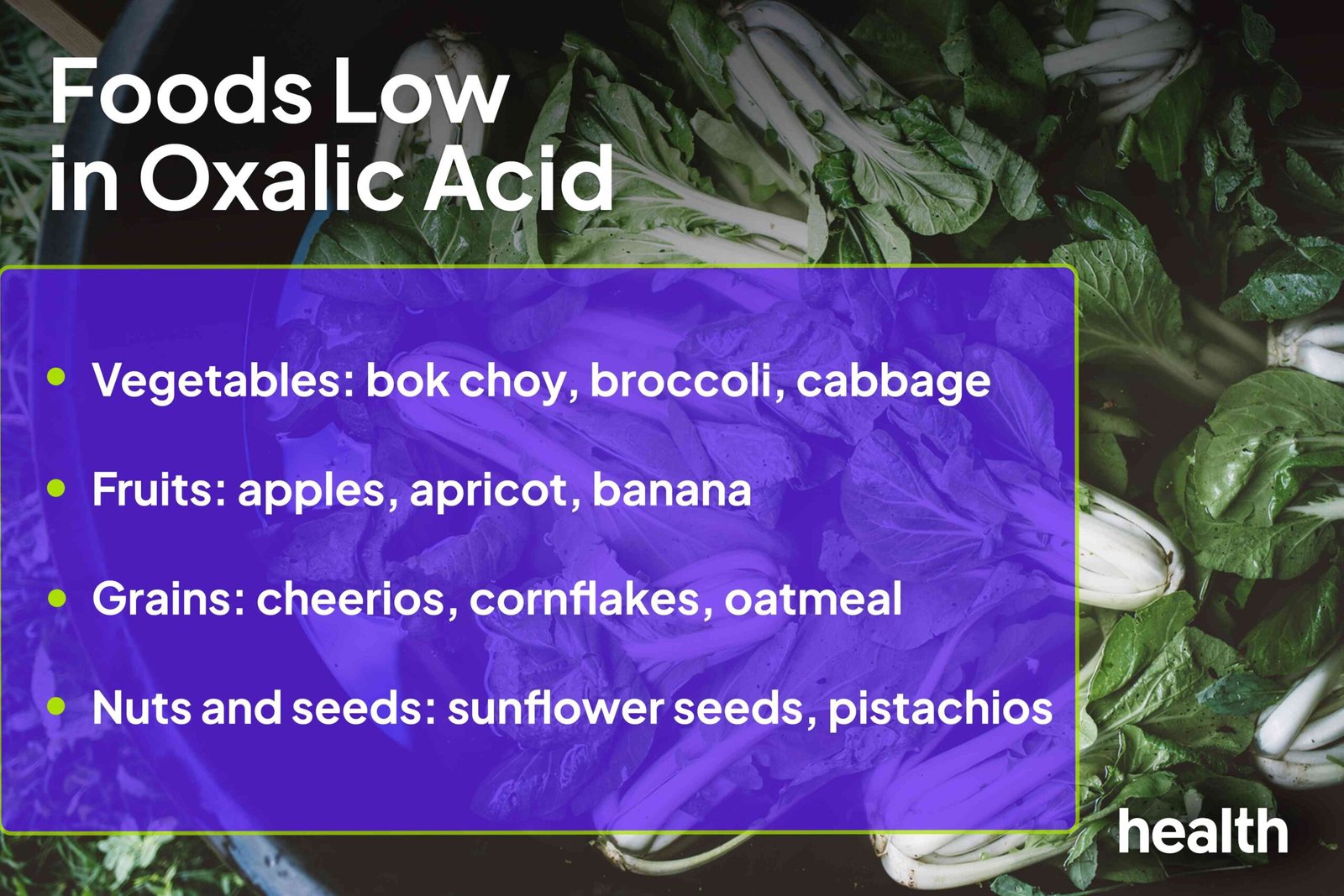
Oxalic acid, or oxalate, is a naturally occurring organic compound in plant foods like vegetables, fruits, grains, and nuts. Your body also produces small amounts of oxalate.
Oxalic acid is sometimes classified or referred to as an “anti-nutrient.” In the digestive system, oxalic acid can bind to minerals like calcium and inhibit their absorption. Many oxalate-rich foods are packed with essential nutrients that benefit health.
People with certain health conditions, such as a history of kidney stones, may need to limit oxalate in their diet. Most people can safely consume various oxalate-containing foods within a balanced diet.
Design by Health / Stocksy
There is no recommended daily intake (RDA) for oxalic acid, since it’s not an essential macronutrient, vitamin, or mineral. The amount of oxalate a person may consume varies depending on their diet. Most people consume between 50-200 milligrams of oxalate per day, while some may consume up to 1,000 milligrams of oxalate per day.
Consuming high amounts of oxalic acid may have some risks, especially if you have kidney disease or are prone to kidney stones.
Increase Risk for Kidney Stones
A high dietary intake of oxalate is linked to hyperoxaluria, a condition where excess oxalate is present in the urine. Hyperoxaluria is a risk factor for kidney stones.
About half of the oxalate excreted in urine comes from dietary sources, while the body produces the other half. Within a 24-hour period, the typical oxalate level excreted through urine is 20-40 milligrams per 1,000 milliliters of urine, with ideal levels being 25 milligrams or less.
The urinary oxalate level in mild to moderate hyperoxaluria is about 40-60 milligrams. An increased dietary intake of oxalic acid is typically the cause of mild to moderate hyperoxaluria.
For every 100 milligrams of dietary oxalate consumed, the amount excreted in your urine increases by 1.7 milligrams. Research shows a link between higher urine oxalate levels and an increased risk of kidney stones. For example, increased urinary oxalate levels from 20 to 40 milligrams raise a person’s kidney stone risk from 2.5 to 3.5 times.
People with a history of kidney stones or kidney disease may benefit from consulting with their healthcare provider to determine if a low-oxalate diet is appropriate.
May Inhibit Mineral Absorption
Consuming high amounts of oxalic acid may prevent you from getting all the necessary nutrients. Oxalate can bind to minerals like calcium and magnesium in the digestive tract, potentially reducing their absorption. While too much calcium may contribute to kidney stone formation, adequate calcium intake can help prevent kidney stones and support overall health.
Many nutritious foods contain oxalate. Being aware of oxalate content is essential, especially if you have certain conditions. Foods high in oxalate include:
- Vegetables: Spinach, Swiss chard, sweet potatoes, potatoes, beets, rhubarb, taro
- Fruits: Avocado, dates, figs, orange, pineapple, raspberries, kiwi
- Grains: Amaranth, wheat bran, cream of wheat, shredded wheat
- Nuts: Almonds, cashews, peanuts, macadamia nuts
- Legumes: Soybeans, lentils, peas, chickpeas
If you’re trying to limit your oxalate intake, these nutritious foods are low in oxalic acid:
- Vegetables: Bok choy, broccoli, Brussels sprouts, cabbage, cauliflower, cucumber
- Fruits: Apple, apricots, banana, blackberries, cherries, mango, peach
- Grains: Cheerios, cornflakes, oatmeal, puffed rice
- Nuts and seeds: Sunflower seeds, pistachios, flaxseeds
- Proteins: Meat, chicken, fish
- Dairy: Milk, hard cheese, yogurt, cottage cheese, ice cream
There are no direct health benefits to consuming or seeking out oxalates.
Many foods containing oxalic acid are nutrient-dense and essential to include in a balanced diet. These foods, such as leafy green vegetables, nuts, and seeds, provide essential vitamins, minerals, and dietary fiber that support overall health and well-being.
Focus on consuming a variety of high- and low-oxalate foods. A balanced diet is key to ensuring you meet your nutritional needs.
Here are a few strategies you can use to reduce the number of oxalates in your diet:
- Cook high-oxalate vegetables, grains, and legumes: Boiling or steaming can significantly reduce oxalate content. Research found that cooking lentils for 15 minutes lowered their oxalate content by 43%. Cooking also enhances their mineral availability, meaning your body can better absorb minerals found in these foods.
- Balance your diet: For a variety of nutrients, incorporate both high- and low-oxalate plant-based foods into your diet.
- Stay hydrated: Drinking plenty of water helps flush out excess oxalate and prevents the formation of kidney stones.
- Consume adequate amounts of calcium: Adults should aim for the recommended daily calcium intake of 1,000 milligrams and limit their intake to less than 2,500 milligrams per day.
- Pair high-oxalate foods with foods rich in calcium: This may help offset oxalate’s absorption of calcium in the body, keeping your calcium levels normal. Consider sprinkling almonds over a cup of yogurt or enjoying a handful with a glass of dairy milk.
- Talk to your healthcare provider: They can help you determine whether a low-oxalate diet would be beneficial for you and offer you individualized guidance.
Oxalic acid, or oxalates, are naturally occurring compounds found in many plant-based foods. While sometimes referred to as “anti-nutrients” due to their ability to bind with minerals like calcium, reducing nutrient absorption, oxalates are not inherently harmful.
High oxalate intake can increase the risk of kidney stones in certain individuals, but cooking oxalate-rich foods can significantly reduce their levels. For overall health, it’s essential to maintain a balanced diet rich in various plant-based foods.






